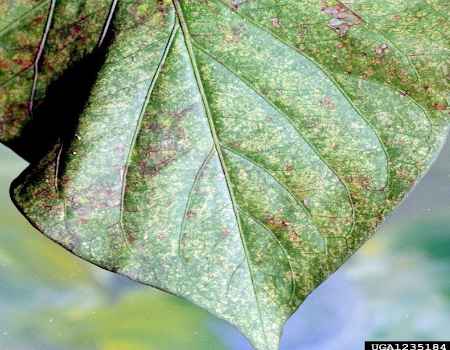By John Tooker
While much of the state is experiencing sustained hot weather, it is good to consider a few pest species (two insect species and one mite species) that do very well in hot conditions and can cause problems for growers. The first to consider is potato leafhopper, whose damage materializes more quickly in hot, dry conditions —this season leafhopper populations are pretty high across Pennsylvania, but their local populations can be spotty with some fields infested and other not. In most years, we only consider potato leafhoppers to be pests of alfalfa (and potatoes), but in hot, years potato leafhoppers can be problematic for other crop species including soybeans. Symptoms of damage in soybeans look very similar to hopperburn commonly seen in alfalfa with yellowing developing at the leaf tip and then spreading in a V-shape down the midrib. Appropriate thresholds are five leafhoppers per plant for V4 stage soybeans, or nine hoppers per plant for R1-2 stage beans.
Two other pest species to keep in mind in the heat are grasshoppers and two-spotted spider mites. Grasshoppers are currently evident in many corn and soybean fields (Figure 1). Grasshopper populations tend to develop first along field edges, often after adjacent alfalfa or small grains have been harvested, so treating border rows can be a good approach. Controlling adults, which have functional wings, is more challenging than controlling nymphs, which can not fly, but only hop, so keep an eye on fields so you know which lifestage your grasshoppers are in to avoid being caught off-guard. Economic thresholds for grasshoppers in corn and soybeans are poorly developed for the eastern US. Growers can use the informal range of 20-40 grasshoppers per square yard to help guide their treatment decisions. Organophosphates tend to provide less residual control against grasshoppers than pyrethroids. If our weather continues to be hot and dry, insecticide use against grasshoppers has potential to flare spider mite populations, so if you decide to treat for grasshoppers return to those fields regularly to watch for development of other pest populations. See the Penn State Agronomy Guide for insecticide options
Two-spotted spider mites produce distinctive stipling on leaves (Figure 2), and fields will slowly bronze as more and more leaves suffer from increasing damage. This bronzing will often start on a field edge, and this tendency of spider mite damage to accumulate on edges can be exploited for management purposes if the interiors of fields are not infested because treatments can be applied to only the field perimeters. If mites are present on the edge of fields, assess the rest of the field by moving at least 100’ into the field and scouting again. In this hot, dry weather, growers might want to develop an aggressive scouting schedule (about every other day). If you see leaf discoloration, can identify mites present in the field, and hot, dry weather continues to be forecast, a treatment may be necessary. Rains can help keep populations in check by reducing plant stress and allowing key beneficial fungi to be more effective. If you have a large field and see damage only along the field borders, a spray directed on the affected area and into the field about 100 feet farther may contain the problem. If you have a small field, plan on treating the entire field. Products labeled against spider mites do not kill eggs and have a short residual, so hatching spider mites can begin rebuilding the population in a few short days. For more details on spider mites, see our fact sheet .
One further note on chemical control of spider mites. Dimethoate is preferred by many for managing spider mites but it is good to realize that spider mite populations vary in their susceptibility to the toxin. Some populations are easily killed by the product whereas others are more difficult to manage. This variation has been recognized for some parts of the country for a while, but may also apply to Pennsylvania. In the past, we heard of dimethoate applications that seemed to have no effect on two-spotted spider mites. We would be curious to hear from readers of other instances where they feel that this product was not effective, so please drop us an email. If you encounter a population that does not respond to dimethoate, you will need to consider other products labeled against two-spotted spider mite, mainly products containing the active ingredient bifenthrin. See the Penn State Agronomy Guide for details.

Figure 2. Feeding damage by two-spotted spider mites starts as stipling and progresses to bronzing as the damage worsens
Source : psu.edu